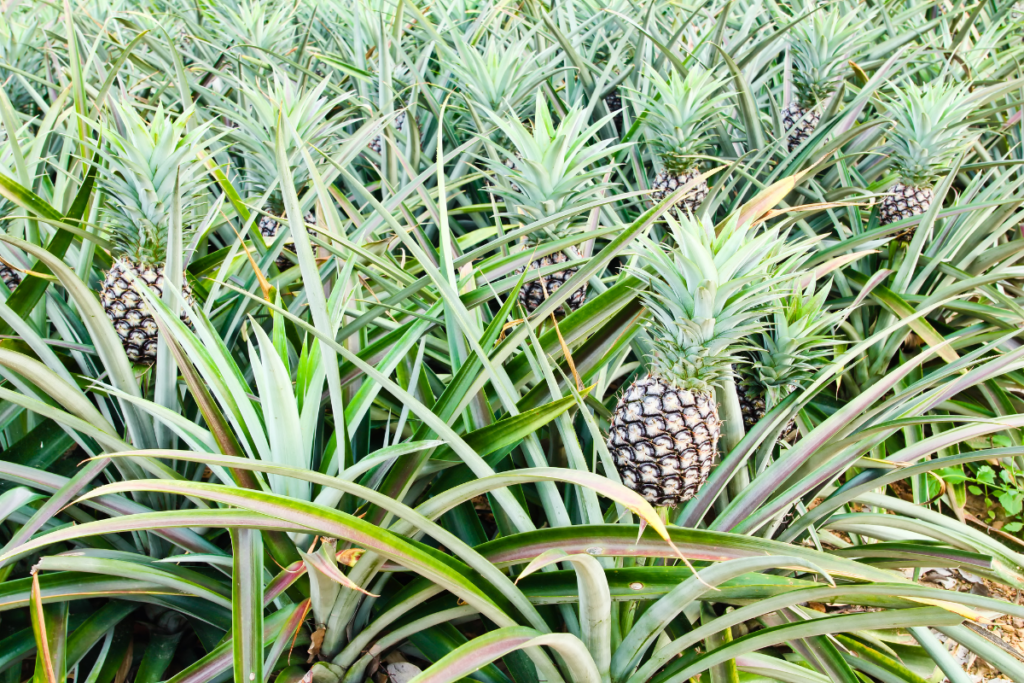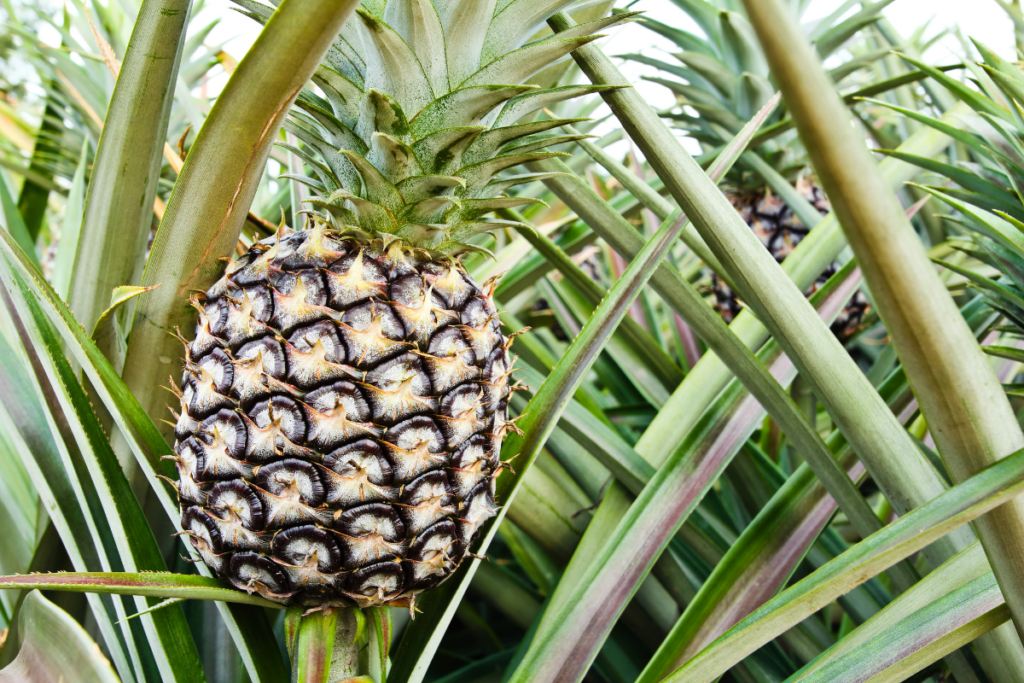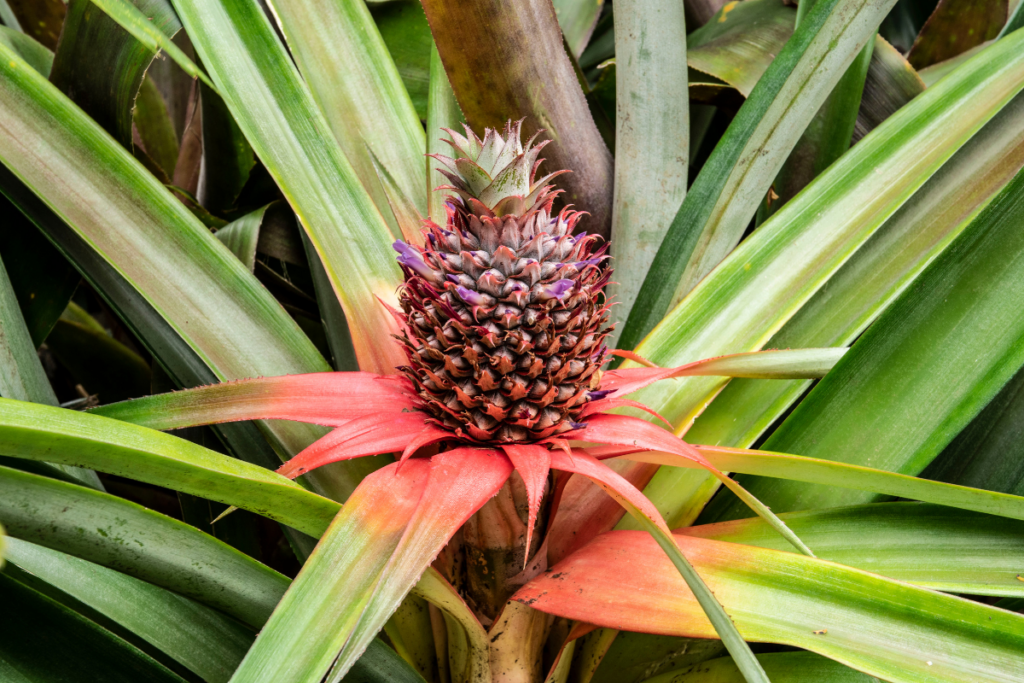Most people don’t give it much thought, but producing pineapples at home is more straightforward than you may imagine. It is actually incredibly refreshing and gives your house a wonderful scent. But how long does it take for a pineapple to grow?

Pineapples typically take between 16 and 24 months to bear fruits. It might take longer if you don’t live in a tropical climate or if you cultivate your pineapple indoors. Because it takes 200 blossoms to produce one fruit, these tropical plants take a very long time to mature.
As we get started, we’ll talk about everything pineapple-related and how long it will take for yours to mature. Let’s go straight into this subject in this article!
General Timetable of Pineapple Growth

The method used to root the plant, the planting zone, and whether it is indoors or outdoors affect how long a pineapple takes to grow.
In a tropical environment outside, you may see fruit as soon as 16 months under what a pineapple regards as typical conditions.
Remember that a pineapple is a tropical plant. Hence, In states like Hawaii, this is frequently the growth time before you get a mature pineapple plant.
However, it may take up to 24 months to grow a pineapple if you’re growing it inside in a climate like Florida. Expect a blooming and fruiting cycle that is significantly longer than 24 months if you’re trying to grow it in a region like southern Illinois.
The method used to create the plant will also have an impact on how it develops and when a pineapple will bear fruit.
When Does A Pineapple Bear Fruit?
Whether you plant tops, suckers/pups, or slips depends on the variety, your environment, how well you take care of them, and how well you take care of them.
It might feel like an eternity to grow pineapples from the tops of pineapples you buy at the store. However, to fruit, tops need roughly 24 months (even longer in colder climates). Suckers require approximately 18 months, whereas slips can bear fruit in just one year.
This tropical fruit often begins to produce pineapple flowers as soon as it reaches a certain size, so the happier it is, and the better you take care of it, the sooner it will bloom. Unfortunately, it takes longer to cultivate pineapples outside of their natural (tropical) habitat.
The fruit of a pineapple must mature for a further six months after it blooms. A long-term investment, growing pineapples for fruit is undoubtedly.
When the fruit begins to turn yellow, it is ready to be picked. If the fruit appears to be getting burnt or if you have four-legged marauders, chop it immediately and keep it on the kitchen counter for a few days.
If not, let it grow until it is fully ripe and golden, then plant the top after cutting it. It gets simpler and faster once the first few pineapples are developing. A fully grown pineapple plant produces many suckers and fruit much more quickly.
Theoretically, you could have hundreds of them in a few years if you had enough space. After then, it is irrelevant how long it takes for anybody of them. Some of them will always be in fruiting.
How Many Times Does A Pineapple Bear Fruit?
A pineapple plant will normally fruit 1-3 times during the course of its lifetime. However, you will observe a pineapple plant live for years at a time because this species is perennial.
There are only three batches per plant because of the lengthy fruiting process. Additionally, if your plant is unhealthy, you could only get one or two pineapples from it.
In general, your pineapple plant will produce tastier and more frequently the healthier it is. However, it’s also important to note that the majority of gardeners only get to see their pineapple plant bear fruit once before they have to replace it.
With this fruiting species, you take a chance because no two plants are identical. Therefore, to ensure that you get a few pieces of fruit when harvested, we advise cultivating many pineapples in your yard.
Do Pineapple Plants Die After Bearing Fruits?
It is normal for your pineapple plant to have some dieback after producing a pineapple. However, at its base, the mother plant will still create new offset plants that you may harvest and transplant.
Therefore, although this species officially dies after fruiting, it also generates a new pineapple plant or plants that you may utilize to yield fruit in the future.
One thing to keep in mind is that you must cut the new baby plants away from the mother plant. If you don’t do this, your new offsets probably won’t grow big enough to produce fruit, which would undermine the point of having them.
Again, it should take two years before fruit appears, so there is now no reason for concern.
In order to promote quicker development, we advise concentrating on your present mother pineapple plant, providing it with lots of sunlight, and providing it with once or twice weekly waterings.
How To Force Pineapple Growth
In order to get the most out of your plant, if you are just starting out with pineapple growing, make sure to conduct a little study on how each of these techniques operates.
However, there are several things you may do if you want fruit as quickly as feasible. Not the fruiting stage, but the blossoming phase, has to be understood and manipulated. After flowering, the fruit doesn’t start to appear for roughly five to seven months.
Can You Plant Pineapples From Seeds?
Yes, if you wish to cultivate pineapples from seed, you actually can! That said, before you can anticipate any development, you must locate a few healthy seeds to sow on the earth.
As we previously stated, the mother pineapple plant should yield offsets for you to replant; however, for novice pineapple gardeners, seeds are OK.
Cut a slice of pineapple fruit and check for small, black seeds around three-eighths of an inch from the edge if you want to attempt growing seeds from it. Once you have gathered your seeds, you can bury them in the ground. To promote germination, give your pineapple plants lots of water.
There are many possibilities available, and if you don’t want to wait as long, you may even buy semi-grown or rooted pineapple plants.
RELATED: 15 Fruits With Low Glycemic Index (Including Pictures)
Different Ways of Planting Pineapple

A pineapple plant may be grown in a variety of ways. Although creating it from scratch is a possibility, it takes the longest. Use of the top, slips, hapas, suckers, or ratoons are different methods.
The mother plant leaves behind the items listed below when it blooms, produces fruit, and eventually dies, in addition to the top item.
1. Planting Using Pineapple Crown
The top of a pineapple, like the part that is connected to the fruit in the grocery store, is called a crown. The most common and straightforward way to start a pineapple plant is using this.
Gently grasp the top pineapple leaves, as well as the leaves around the fruit, and carefully twist them off. Make sure to remove all the fruit flesh.
It’s crucial to keep in mind that you cannot plant fruit that has had a hole drilled into the top of it. Some growers of fruit will pierce the crown. This was done on purpose to make it impossible for you to plant it.
If you intend to use a crown, be aware that it might take up to 28 months or possibly longer for it to mature and bear fruit. Although they aren’t as drought-resistant as other techniques, adopting them has the advantage of helping plants grow a stronger root system.
Before planting, some gardeners advise letting the crown dry for up to two weeks. Some advise planting the crown immediately away, while others advise letting the plant root in a glass of water. You’ll need to experiment with your personal tastes and what works best for you.
2. Planting Using Pineapple Slips
Small plants called slips have a curved form and grow from the base of the plant up the sides of the stalk, which is also referred to as the peduncle. They resemble a more primitive, scaled-down form of the plant.
When the mother plant is approximately half developed, they start to develop. In roughly 10 to 13 months, you may handoff the slips for planting. Regular slip breaking off helps the mother plant produce additional ratoons.
These should not need to be dried after being plucked from the peduncle; it is preferable to plant them right away. As soon as 24 months after the seeds were planted in the ground, you may start to see fruits.
3. Planting Using Pineapple Suckers
Suckers, which are larger and older plantlets growing off of the peduncle, are also plantlets. They originate from a bud, therefore you’ll need to use a knife to cut them out.
These have a propensity to blossom, which might be detrimental to productivity and harvesting. So, you may start growing a plant now, but be aware that there can be some issues.
Because fruits can develop as soon as 16 months after planting, many gardeners affirm that this variety grows the fastest. However, if the suckers on the peduncle are left untreated, a “ratoon crop” develops.
4. Planting Using Ratoons
Ratoons are the mother plant’s secondary fruits that continue to develop long after the blooming, fruiting, and demise stages. Ratoons are little plants that can start to develop after just one year, hidden between the mother plant’s leaves. By gently twisting them, take them out from the mother’s base.
5. Planting Using Hapas
Hapas are in the middle of the size spectrum, between little slips and big suckers. They are simple to manually cut off. These emerge from the base of the peduncle and are considerably straighter than slips.
Perfect Location For Growing Pineapples
Despite the fact that they may grow everywhere, pineapples prefer warm, sunny weather all year long and well-draining soil. Therefore, growing pineapple will be simpler in California than it will be, for instance, in Maine.
However, these succulent, sweet, and delicious fruits grow well in pots, which is what makes them ideal for indoor cultivation. However, they thrive on the open dirt, like the majority of plants.
If you’re fortunate enough to reside in the 11–12 growing zone, you can leave the plant’s outgrowth, which will result in the creation of other plants.
It will need extra care and attention to work with this plant if you grow pineapples indoors. To ensure that it develops more quickly and doesn’t become crowded, you must eliminate all plantlets and outgrowth.
What Is The Ideal Temperature for Growing Pineapples?
The optimal temperature for pineapples to produce the greatest and sweetest fruits is maintained in the range of 68 degrees Fahrenheit to 85 degrees Fahrenheit. However, you may experiment with the temperature to hasten the flowering phase, which will ultimately hasten fruiting.
Shorter periods of sunlight can be used to make it cooler, which results in blooming as a consequence. However, you may also ignore it and overexpose it to heat, subjecting it to conditions that are quite similar to a drought.
The fruit will be smaller if you use the heat option, though. If you utilize cold to hasten flowering, be careful not to do it before the plants have grown much because this will result in lesser fruit.
Using Chemicals To Induce Plant Growth
It is preferable to utilize chemicals to speed up development during cooler seasons rather than during hotter ones. Also, keep in mind that employing these suggested chemicals will come with some cautions because they are quite corrosive.
Ethephon
Ethephon is a plant growth regulator that was first identified in 1965 and was approved for use as a pesticide in 1973.
It’s a highly-liked option for farmers and larger agricultural, but it also works well for individual usage. Spraying it on or incorporating it into the soil is proven to help pineapples produce flowers.
However, utilizing this comes with certain health warnings because it might irritate the skin, eyes, and other sensitive tissues.
Calcium Carbide
When calcium carbide and water are combined, the chemical combination produces acetylene gas. While helping pineapple plants produce flowers, this gas also comes with certain risks. This gas can irritate the eyes, skin, nose, throat, and lungs, in addition to being very combustible.
How To Fertilize Pineapple Plants?
Nearly all plants require a decent fertilizer to yield attractive results. The same is true with pineapple.
Potassium, phosphoric acid, nitrogen, and magnesium are among the nutrients that should be present in the ideal dry fertilizer mixture for pineapples. They ought to have a little less magnesium and be at around 6–10% apiece. These should be included as well as a modest combination of nutrients in liquid fertilizers.
Fertilize young plants roughly every eight to ten weeks. Increase the frequency as the pineapple becomes older. Remember to always adhere to the manufacturer’s guidelines.
Tips on Fertilizing Pineapple Plants
- For the first few months after planting, pineapples exclusively rely on their leaves since they absorb a large portion of their nourishment through those parts of the plant. Make sure the plant food touches the leaves where it should.
- Avoid using chemical and concentrated fertilizers since doing so can cause your pineapple to burn. They should be avoided at all costs. Typically, they cause more harm than benefit.
- You can use liquid fertilizers like seaweed extract or fish emulsion. Simply use a watering can to apply a very weak solution to the pineapple plant’s surrounding soil.
- Because the pineapple plant has a very limited root system, you should use something like pelleted chicken manure and make sure some of it gets into the bottom leaves.
- Of course, a natural and organic method that doesn’t involve purchasing anything is by far the greatest option.
- Before planting the pineapple, incorporate compost into the soil, and then mulch the area surrounding it heavily. As mulch and compost decompose, they end up in the bottom leaves where they nourish the plant.
- Your pineapple plant’s color of leaves will indicate how well you are doing. Your pineapple is famished and needs attention if it has a reddish, purple tint.
What Is The Optimal Water Amount to Grow Pineapple Plants?
In essence, the amount of water is unimportant. Just give them what you can if you live in a dry location and have limited access to water. Pineapples need relatively little water to flourish.
To stop soil from evaporating, be sure to mulch it heavily, and think about planting pineapples in some shade.
Of course, this depends on the climate where you reside. The more shade your pineapples can tolerate depends on how near to a tropical or subtropical climate you are.
Pineapples will require as much sunlight as possible in the summer if you have to grow them indoors during the winter due to your region’s environment.
Great if you have a lot of water. It’s OK for the plant to constantly have water in the center of the rosette, because everything excessive will simply drain away and run off. However, it can be a total waste of water resource, therefore, you should try to not overwater.
Remember the fact that extra water can swiftly drain away into the soil. Hence, avoid attempting to cultivate them in a bog hole.
Final Thoughts
The process of growing pineapple may be time-consuming yet lucrative. However, there are a few actions you’ll need to follow with regular care and attention if you want to speed up their growth. You’ll get the finest outcomes if you take the time to learn and comprehend how one is grown.
Editor’s Recommendations
16 Different Black Fruits (Including Photos)







